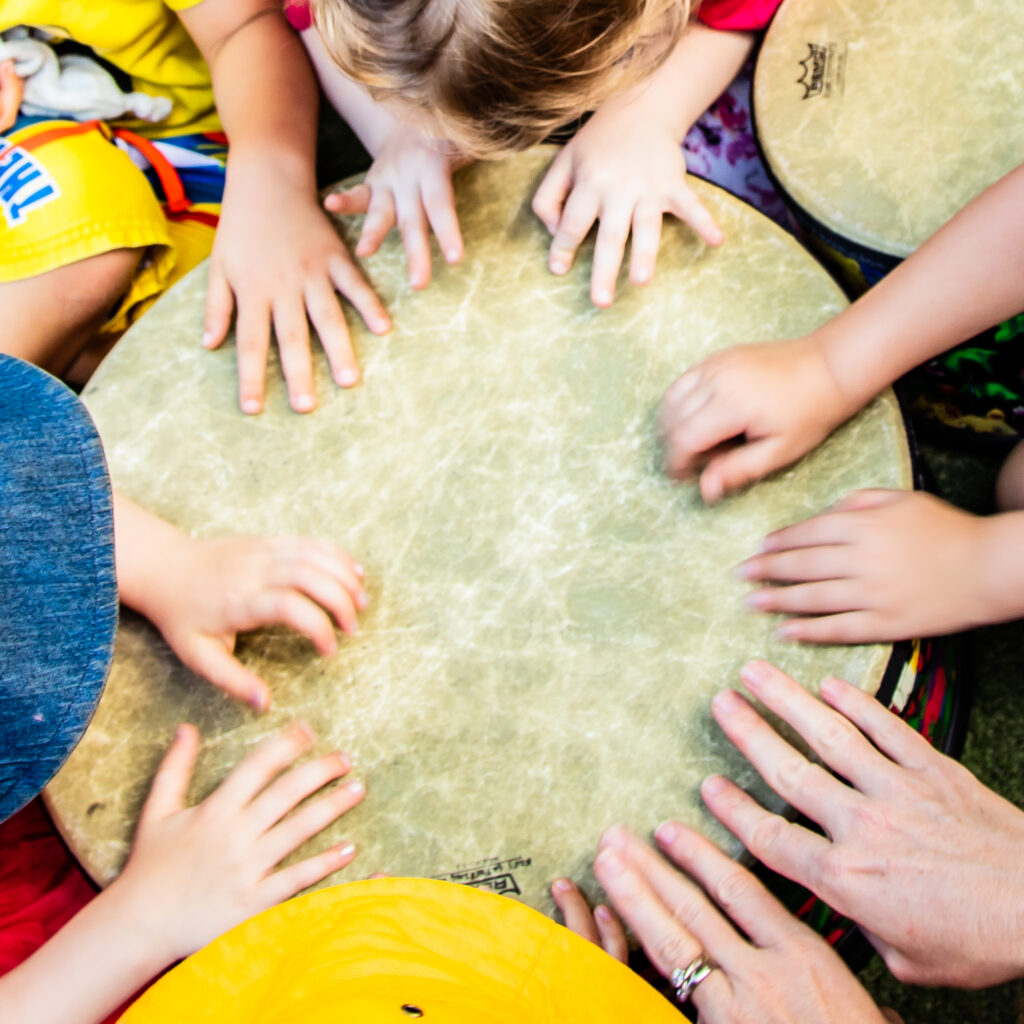
To date there have been limited early childhood educational approaches that capitalise on the advances in the neuroscience of self-regulation, and none that bring these understandings together with the known neurological benefits of music training and music therapy principles. Distinct synergies across these areas of research suggest that a specifically designed rhythm and movement intervention has the potential to improve early childhood self-regulatory skills.
First, emerging evidence suggests that the ability to keep time by moving or tapping to a given beat (beat synchronization) is an important neurodevelopmental marker1. Like self-regulation, beat synchronization improves with age and is positively associated with markers of school readiness including auditory perception and early language skills2. Importantly, children with executive function deficits also show deficits in rhythm perception suggesting there may be shared underlying neural mechanisms across rhythm perception and self-regulation3. Second, a growing body of research shows that music training is associated with enhanced neural plasticity and executive functioning in both adult and child musicians (the ‘musician advantage’) 4,5. This advantage is thought to be a result of the enhancement of shared neural networks involved in rhythm perception and parallel non-musical cognitive functions4. These shared neural networks provide the opportunity for rhythm engagement to generate non-musical domain-general benefits such as self-regulation skills6,7. This effect is leveraged in clinical populations by music therapists who use beat synchronization and rhythmic auditory cueing to improve cognitive and motor functions in brain-injured patients6,7. Third, coordinated movement has been documented as effective in stimulating self-regulation benefits, particularly in early childhood8. Coordinated movement activities both require employment of the self-regulatory systems of the brain, and build the neural circuitry relevant to self-regulatory functions9. A review on interventions known to improve children’s executive functions concluded that a common characteristic of effective approaches is active sensory-motor involvement which supports brain-body neural connections10 (e.g. martial arts, yoga, dance). Finally, supporting such coordinated movement with rhythm as is done with clinical populations6,7 is likely to further enhance these positive effects by stimulating the same shared neural networks that are enhanced in trained musicians. Some limited evidence suggestive of this effect has been documented with early childhood formal music and dance class participation8, and informal home music engagement11 linked with increased self-regulatory skills in preschool children. Still, harnessing the “musician advantage” to address underlying neurological differences in disadvantaged children that underpin self-regulation development has not been done. Taken together, it is highly promising that a specifically designed structured rhythm and movement program that supports beat synchronization and coordinated movement skills in children, while simultaneously targeting specific self-regulation skills with rhythmic support would be effective.
References
- Thomspon, E., White-Schwoch, T., Tierney, A., & Kraus, N. (2015). Beat synchronization across the lifespan: Intersection of development and musical experience. PlosOne, 10(6).: e0128839. Doi: 10.1371/journal.pone.0128839
- Woodruff Carr, K., White-Schwoch, T., Tierney, A.T., Strait, D.L., & Kraus, N. (2015?). Beat synchronization predicts neural speech encoding and reading readiness in pre-schoolers. PNAS. Doi:10.1073/pnas.14062191111
- Lesiuk, T. (2015). Music percdeption ability of children with executive function deficits, Psychology of Music, 43(4), 530-544. Doi:10.1177/030573561452268
- Luo C., Guo Z. W., Lai Y. X., Liao W., Liu Q., Kendrick K. M., et al. (2012). Musical training induces functional plasticity in perceptual and motor networks: insights from resting-state FMRI. PLoS ONE7: e36568 10.1371/journal.pone.003656
- George, E.M., & Coch, D. (2011). Music training and working memory: An ERP study. Neuropsychologia, 49(5). 1083-1094.
- Thaut, M., Gardiner, J.C., et al. (2009). Neurologic music therapy improves executive function and emotional adjustment in traumatic brain injury rehabilitation. Annals of the New York Academy of Science, 1169, 406-416
- Thaut, M. (2010). Neurologic music therapy in cognitive rehabilitation. Music Perception, 27, 281-284
- Winsler, A., Ducenne, L., & Koury, A. (2011). Singing one’s way to self-regulation: The role of early music and movement curricula and private speech. Early Education and Development, 22(2), 274-304. doi: 10.1080/10409280903585739
- Chang, Y.-K., Tsai, Y.-J., Chen, T.-T., & Hung, T.-M. (2013). The impacts of coordinative exercise on executive function in kindergarten children: An ERP study. Experimental Brain Research, 225(2), 187-196. doi: 10.1007/s00221-012-3360-9
- Diamond, A., & Lee, K. (2011). Interventions shown to aid executive function development in children 4 to 12 years old. Science, 333(6045), 959-964. doi: 10.1126/science.1204529
- Williams, K.E., Barrett, M., Welch, G., Abad, V., & Broughton, M. (2015). The longitudinal benefits of early shared music activities in the home: Findings from the Longitudinal Study of Australian Children. Early Childhood Research Quarterly.